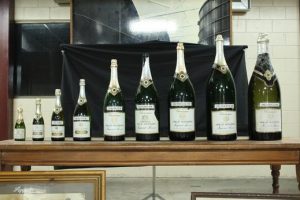
Bottles for wines are produced in a wide array of sizes and shapes. The main change in sizes and shapes for wine bottles began taking place in the early to mid 1700’s.The different wine bottle shapes and sizes started taking shape once it was discovered that cork could act as a sealing agent, which allowed the wines to age or at least not spoil.The next step in the evolution of wine bottle shapes and sizes came about when it was discovered that larger bottles not only looked better, they could also change the taste of a wine. This ability to change took place because the larger sized wine bottles allowed the wine to age and develop over longer periods of time than the standard glass bottles of the day.It is a fact that wine from larger format wine bottles age more slowly and develop more complexity and nuances than wines from smaller wine bottle sizes. This is due to the smaller amount of air, or more accurately, (oxygen and sulfur dioxide) that resides between the cork and the wine.The surface to air ratio between the wine and the bottom of the cork is called ullage. The amount of ullage can either oxidize the wine, causing it to age prematurely, or develop at a slower pace of maturity. The more air the surface of the wine is exposed to, the faster the wine is going to develop.
The method of making champagne was originally discovered by Dom Perignon, a Benedictine monk who died in 1715. Champagne is sold in a half bottle, sometimes called a pint, a standard 750ml bottle, or a magnum which holds 2 bottles.
From here on the bottles have biblical names. No-one knows why; it is simply an old custom carrying on from wine lore of the past.
Next time you head to the Grampians, pay a visit to the Seppelt Cellar Door in Great Western and you’ll be able to see a fantastic display of the different bottle sizes on the historic underground cellar tour. People often like to buy the novelty bigger bottles of champagne for special occasions or as gifts. Wine bottles come in all different shapes as well. Below are a few of the most common shapes of bottles:
Lorem Ipsum has been the industry’s standard dummy text ever since the 1500s, when an unknown printer took a galley of type and scrambled it to make a type specimen book. It has survived not only five centuries, but also the leap into electronic typesetting, remaining essentially unchanged.
Great Western Enterprises work on the magnificent Gariwerd landscape of the Wotjobaluk, Jaadwa, Jadawadjali, Wergaia and Jupagulk people, the traditional custodians. We respect their land and their cultures and we pay our respects to their Elders, past, present and all Aboriginal Elders of other communities who may be here today.
Liquor Licence Number 32800105.
LIQUOR ACT 1982 It is an offence to sell or supply to or to obtain liquor on behalf of a person under age of 18 years. Seppelt Wines encourages a responsible attitude to the consumption of alcohol.
© Great Western Enterprises Pty Ltd 2023
Let’s book your next amazing experience at Seppelt Great Western.